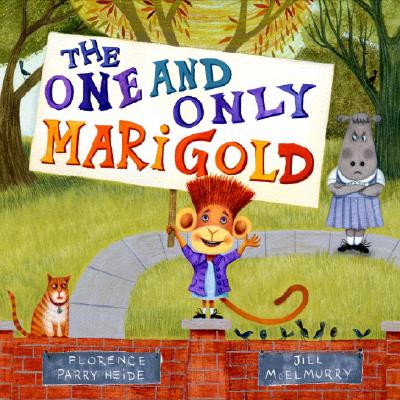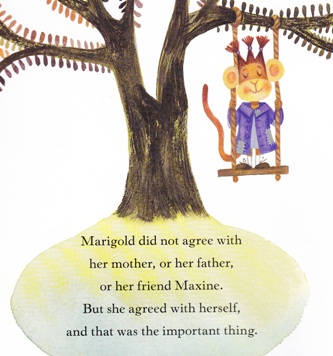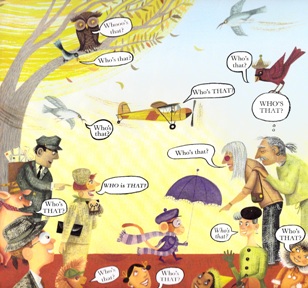Sometimes the world is a weirdly bittersweet and wonderful place. I spent most of this evening typing out a long tribute to The One and Only Marigold, a picture book that I dearly love and a book that my daughter adores. As I finished the article and began searching for hyperlinks to accompany the text, I saw on the internet that it was just announced that Florence Parry Heide, the author of the book, had passed away in her sleep last night. She was an amazing 92 years old and authored over 80 children’s books during her prolific career. What an amazing woman and what a huge loss for children’s literature.

Lane Smith helps his collaborator on Princess Hyacinth (The Surprising Tale of a Girl Who Floated) (Random/Schwartz & Wade), Florence Parry Heide, celebrate her 90th birthday.
I had the pleasure to meet her once in 2009 and she couldn’t have been more charming. So, in tribute of the favorite daughter of Kenosha, Wisconsin and an author that has created far too many books that my daughter has fallen in love with, I offer this heartfelt tribute to The One and Only Marigold and of Florence Parry Heide herself. Honestly. If you love great children’s books, pick up ANY of her titles and you’ll be happy you did.
My tribute to The One and Only Marigold now feels a bit self-indulgent – Mrs. Heide deserves a better elegy than I could ever write – but I want to leave my original article pretty much intact to simply show off the sheer fanboy-ish glee that this wonderful woman inspired in a grouchy thirty-something dad. You will be missed, Mrs. Heide.
And now, onto The One and Only Marigold …
####
As I’ve mentioned before, when looking for books for my daughter, my favorite thing in the world is the unexpected surprise. I LOVE stumbling upon a book I’ve never heard of before and having that moment of discovery – like all the secret knowledge of the world has just fallen into my lap.
Now the hilarious irony of these moments is that, usually, when I have them, I’ve accidentally “discovered” something that is already WIDELY known and HUGELY famous. The only person that hasn’t heard of these titles yet is ME. I call them my “Christopher Columbus” moments. I charge ahead and plant a flag on a book, screaming, “LOOK WHAT MY GRAND INSIGHT HAS PLUCKED FROM OBSCURITY! I CLAIM THEE!” And, then, after a proud few moments, someone normally takes me aside and quietly explains that the book was a best-seller, won the Newbery Award, and has been the subject of 10 movie adaptations (5 of which I’ve probably seen).
Case in point – I have that oblivious sense of discovery pride about The One and Only Marigold by Florence Parry Heide and Jill McElmurry. However, I think I’m mostly just happy that I lucked into finding such a delightful picture book, because finding Marigold not only introduced us to a wonderful book, but it also introduced us to the great Florence Parry Heide, who quickly became one of our favorite authors.
I’m not going to try to recount Mrs. Heide’s insanely impressive resume here – try this link or that link for some background – but her prolific career that has included collaborations with a breathtaking variety of authors and artists including Edward Gorey, Sylvia Van Clief, Jules Feiffer, and Lane Smith. She even has her own holiday in her hometown of Kenosha, Wisconsin. And, like an idiot, I hadn’t heard of her until 2009.
I was attending the American Library Association Annual Conference in Chicago and had been hunting the convention floor for a copy of Princess Hyacinth: The Surprising Tale of a Girl Who Floated, a picture book that I’d heard raves about and that had artwork by Lane Smith – one of my favorite illustrators ever since I first read The Stinky Cheese-Man. When I finally found the table where Lane Smith was signing copies of the book, I was introduced to a charming older woman, who, as it turns out, actually wrote Princess Hyacinth. This was Florence Parry Heide.
[Note: If you don’t already own Princess Hyacinth, go buy it now. Right now. Go ahead. I’ll wait. Honestly, it’s that good. I’ll do a write-up of it one day, but Marigold didn’t nearly get the same level of popular attention as Princess Hyacinth, so it can wait. Oh, and her books with Edward Gorey are fantastic too. OK, more on Florence Parry Heide soon.]
She was gracious and so kind as she signed a copy of the book for my daughter and, as she was signing, one of the people working the publisher’s table asked me if I wanted to purchase one of Mrs. Heide’s other books, a book I’d never heard of called The One and Only Marigold. I hesitated for a second (I spent a LOT of money on books at that convention) until the woman working the table locked eyes with me and, with total honesty, said, “It’s so, so good. REALLY.” So I relented and bought a copy of the book I’d never heard of. And, later that night, as I read it aloud to my 2 ½-year-old daughter in our Chicago hotel room, I knew I’d lucked into something really special.
Marigold is a brilliant children’s book, but I think it’s an especially great book if you have a daughter because, not unlike Ian Falconer’s Olivia, Marigold is a wonderfully self-possessed little girl who just stands as this fantastic example of a young woman who is totally, completely comfortable within her own skin. Marigold is silly, headstrong, stubborn, sassy, creative, oblivious, passionate – she’s a very, very complex little girl, but she knows exactly who she is and she’s comfortable with her own quirks. And, I’ll admit, if I can raise my own little girl to have such a deep sense of self-knowledge and such a low sense of angst, I’ll be pretty pleased.
Heide sets the tone of The One and Only Marigold with an epigraph at the beginning of the book: “Marigold did not agree with her mother, or her father, or her friend Maxine. But she agreed with herself, and that was the important thing.”
What a wonderful, unconventional message for kids. So many kids’ books shy away from glorifying what they deem “bad behavior” or they go out of their way to show “difficult children” getting comeuppance for being so contrary. But think about it – do you really want your children to have no spark, no sense of defiance at all? As a friend once told me, “Oh, your kid has some fire in her eyes. That’s perfect. You don’t want a mouth-breather. Yeah, mouth-breathers are easy to handle, but, jeez, there’s nothing there.”
Marigold is definitely not a mouth-breather. She’s a little monkey girl who knows what she wants and constantly finds herself affectionately butting heads with her friends and family because of it. The book consists of four vignettes – which, in my head, I always refer to as “George and Martha Style” – where we see Marigold stubbornly overcoming the objections of her mother and her hippo best-friend Maxine. In the first story, Marigold loves an old ratty purple coat, but when her mother forces her to shop for a new one, she insists on buying a replacement purple coat that barely fits her. (She swears she’ll make up for the buttons not being able to close by wearing a purple scarf, purple shoes, a purple hat, etc.) In the second story, Maxine objects to being counted second on Marigold’s list of best friends – right behind Marigold’s prized purple coat – and, when she states “If I can’t be first, then I don’t want to be on the list at all,” Marigold replies, “All right”. Unfazed, Marigold ignores Maxine’s demands and instead starts brainstorming on how to further bug Maxine. (This is a very funny book.)
Is Marigold stubborn? Yes. Is her behavior questionable at times? Sure. But, she’s in no way naughty. I’m hammering home this point because I’ve read reviews of The One and Only Marigold online where the reviewers say things like “This is a good book, but I explained to my child that Marigold’s behavior is in no way acceptable” – and that drives me NUTS. There is NOTHING wrong with Marigold’s behavior. She’s a young kid. She argues with her mom. When her best friend makes an ultimatum (put me at the top of your best friend list or else!), she becomes antagonistic. She acts like a real person, which is fantastic.
And, later on in the book, in a terrific story about Maxine and Marigold on their first day of school, even though Marigold has just finished antagonizing Maxine in the earlier chapter, she allows Maxine to get away with a lie – they’re both pretending that they’re wearing wild new clothes and hairdos beneath their long coats and hats – because Maxine is her friend and has shown Marigold the same kindness. Marigold is an honest little girl, and Heide does an admirable job of making her emotionally honest too. And I think kids can recognize that honesty in Heide’s words and, as such, really respond to Marigold as a character. My daughter went over the moon for The One and Only Marigold and would talk at length about Marigold’s motivations in each of the four stories – “I think she took Maxine off the list because she didn’t like how Maxine talked to her, Daddy.” I like Falconer’s Olivia, but I really do think that Marigold is a much more grounded, relatable character and, at the very least, my daughter really responded to Marigold as if she were a real person, which is a phenomenal accomplishment for a picture book.
And I haven’t even mentioned the accompanying artwork by Jill McElmurry, which really brings Marigold and her world to life. This is a beautiful book – McElmurry’s illustrations resembles a mixture between an organic folk art style and the graphic, storytelling finesse of renowned Disney artist Mary Blair (whom you might, most recently, remember from her great Google Doodle earlier this October). McElmurry really excels at bringing surprising levels of depth to the facial expressions of Marigold and company and, there’s a particular two-page spread, where a clearly upset Marigold is trying on different coats, that cracks my daughter up every time.
So, are you afraid that you’re raising a mouth-breather? If so, check out The One and Only Marigold and show your kid how being stubborn isn’t always naughty and how sometimes being true to yourself is even more than important than making other people happy. And, if this is your first introduction to Florence Parry Heide, just be happy that a really, truly sublime author is now on your radar.
THE DETAILS ON THE ONE AND ONLY MARIGOLD:
AGE RANGE: The stated range is ages 4-8, but my 2 ½-year-old ADORED this book when we first brought it home.
PAGE COUNT: 40 pages
AUTHOR WEB SITE: There isn’t an official Florence Parry Heide tribute page, which is criminal, but here’s a link to her Wikipedia page and here’s a link to her Facebook page where tributes to her life and legacy are starting to pour in.
BUY IT, BORROW IT, OR FORGET IT?: Buy it. She has more famous works, but this is a fantastic title.
IF YOU LIKED THE ONE AND ONLY MARIGOLD, YOU MIGHT ALSO LIKE:
- The Cowgirl Kate and Cocoa series by Erica Silverman, illustrated by Betsy Lewin – This series also mimics the “George and Martha” structure of four stories per book wherein two friends affectionately butt heads, but ultimately reaffirm their friendship. Cocoa the horse is the mischievous one in the relationship, but I love these easy readers because they’re gentile and clever and have a wonderful take-charge lead female character that my daughter loves.
- The Olivia series by Ian Falconer – When you mention stubborn little girls in the world of children’s lit, Olivia is bound to come up. I’m hot and cold on the Olivia series – some of the titles just never connect with me – but I think she’s a great character who shares a lot of DNA with Marigold.
- 17 Things I’m Not Allowed to Do Anymore by Jenny Offill and Nancy Carpenter – This extremely funny picture book doesn’t have the story and character emphasis that Heide creates in Marigold, but it does have a similar sense of humor, fantastic art, and another headstrong lead girl who doesn’t let a little something like the strenuous objections of her parents stop her from being herself.



{ 0 comments… add one now }
You must log in to post a comment.
{ 1 trackback }